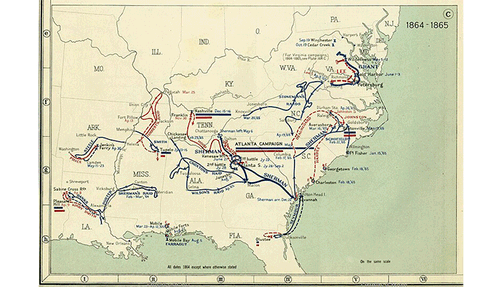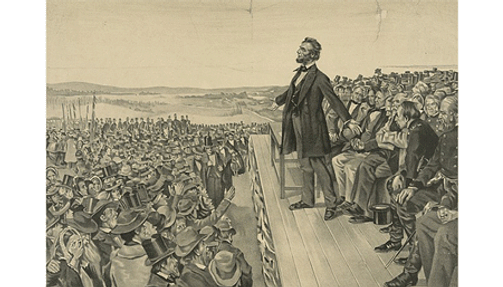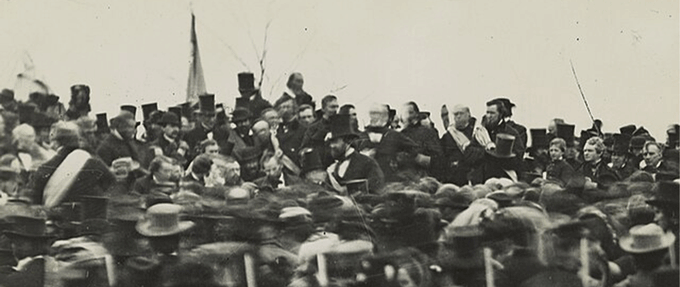On November 19, 1863, one of the most famous speeches in American history was delivered. President Abraham Lincoln took to the podium, although he was not the main speaker that day. Indeed, that was Edward Everett, a former US senator and Harvard president, who had spoken for nearly two hours prior to the president.
But it was not Everett’s words that the crowd of over 15,000 would remember, but the less than two-minute presentation from Lincoln. In his speech, he succinctly put into words what the Civil War represented—and what, in its aftermath, the nation would become.
The audience had gathered for a dedication ceremony at the National Cemetery of Gettysburg in Pennsylvania, where one of the bloodiest battles of the war had concluded just four months ago. He spoke of the ground they stood upon, which, very literally, held the bodies of over 50,000 soldiers—both Union and Confederate.
Lincoln states, “We have come to dedicate a portion of that field, as a final resting place for those who here gave their lives that the nation might live.” It was and is then, the objective of the people who live, to embody the ideals of the nation—that of freedom and equality—so that the unfinished project of the dead may be fulfilled.
What caused the Civil War?
The Civil War pitted Union and Confederate soldiers against each other, representing the North and the South of the United States, respectively. After Abraham Lincoln's election in 1860, 11 slave states seceded from the Union, leaving the 23 remaining states, which sparked the ensuing conflict.
Even before the secession, there was a deep-seated divide between the North and South, particularly concerning the nature of slavery. The history of slavery in America dates back as early as 1616. However, by the 19th century, Northern colonies were working to abolish slavery, while Southern colonies made enslaved labor central to their economy.
The issue was only further deepened by the rise of abolitionists, those who sought to end slavery immediately. Still, although the general population of the North opposed slavery, African Americans did not have equal rights, with segregation still in place and recurrent violence.

Map of the final year of the Civil War.
Photo Credit: Wikimedia CommonsWhen Lincoln won the electoral vote, in the newly formed Republican Party, which opposed slavery, South Carolina was the first Southern state to withdraw from the United States, with the other states quickly following suit.
With each passing week, the secession crisis grew, with, eventually, 25 of the Senate’s 66 members resigning their seats to join the Confederates. When Lincoln took office on March 4, 1861, rumors of a Confederate attack at Fort Sumter were circling and imminent. Quickly, lines were clearly drawn with Senator Stephen Douglas asserting, “Every man must be for the United States or against it.”
What was the purpose of the Gettysburg Address?
In his essay, “Gettysburg Mourning,” scholar Jonathan Lear considers how we remember the battle and the difficulty of making sense of what happened in the days and weeks that followed. What many fail to recognize is that Lincoln’s address was given on the site of both marked and unmarked graves.
The Civil War lasted for more than 4 years, with, according to the American Battlefield Trust, roughly 620,000 casualties, though many estimate higher. Casualties of the Civil War were approximately 2 percent of the total population of the United Sates at the time.
A turning point in the war, the Battle of Gettysburg was also one of the deadliest. Over a three-day engagement, the Union side dashed Confederate general Robert E. Lee’s second attempt at invading the North, which effectively ended their hopes of becoming an independent nation.
In the book A Strange and Blighted Land, Gregory Coco puts together a collection of eyewitness accounts. The following is just one of many harrowing descriptions of the aftermath of the battle: “No words can depict the ghastly picture. The track of the great charge was marked by bodies of men in all possible positions, wounded, bleeding, dying, and dead. Near the line where the final struggle occurred, the men lay in heaps, the wounded wriggling and groaning under the weight of the dead among whom they were entangled.”
It was not possible, then, to walk the field that day without stepping over bodies. And in his address, Lincoln calls attention to the dead around the gathering audience: “It is rather for us to be here dedicated to the great task remaining before us [...] that we here highly resolve that these dead shall not have died in vain.”
Although much of what Lincoln said had been championed by him before, it was his assertion that the Declaration of Independence, not the Constitution, was the true guiding principle of Americans that defined his purpose: “that this nation, under God, shall have a new birth of freedom.”
At this time, many white slave owners were arguing that they were the true Americans, for the Constitution did not prohibit slavery. By beginning with a call to the Declaration, which was formed “Four score and seven years ago” and “dedicated to the proposition that all men are created equal,” the president summed up the war as beyond a Union victory, to a realignment of the nation in human equality.

Lincoln's address.
Photo Credit: Wikimedia CommonsWhat was not said?
A key question in Lear’s essay is how we live with the dead. In Lincoln’s speech and across history, there is an exclusion of the Confederate soldiers from collective memory. Lear argues that the Gettysburg insistence on excluding the others—from “these honored dead”—had terrible consequences.
That is not to say the Confederates’ mission, of furthering a nation reliant on slavery, should be honored—but that America, as a nation committed to realizing “unfinished work,” needs to recollect all aspects of history, even the most harrowing.
Lear writes, “It may be a bitter irony [...] but the exclusion of Confederate dead from national places of mourning contributed to a separation of Northern and Southern cultures and to increased racism and inequality.” He adds, “In the South, Confederate dead have been idealized and glorified; in the North, many arrogantly look down on the South as ignorant and bigoted—and use that trope to exculpate themselves of racism in their own eyes.”
This othering has only continued to become an increasingly pressing issue in today’s America. It is important, then, to evaluate all aspects of history, all sides, separating right from wrong, and forging a path forward—where freedom and equality are not only upheld but practiced each day.
The United States was founded on the belief that “all men are created equal,” a cause that Lincoln dedicated himself to throughout his life. Today, this principle has evolved to encompass diverse expressions of race, sex, and national origin. We must continue to live and embody this “new birth of freedom,” and uphold a government that is "of the people, by the people, for the people."
Featured image: Wikimedia Commons
